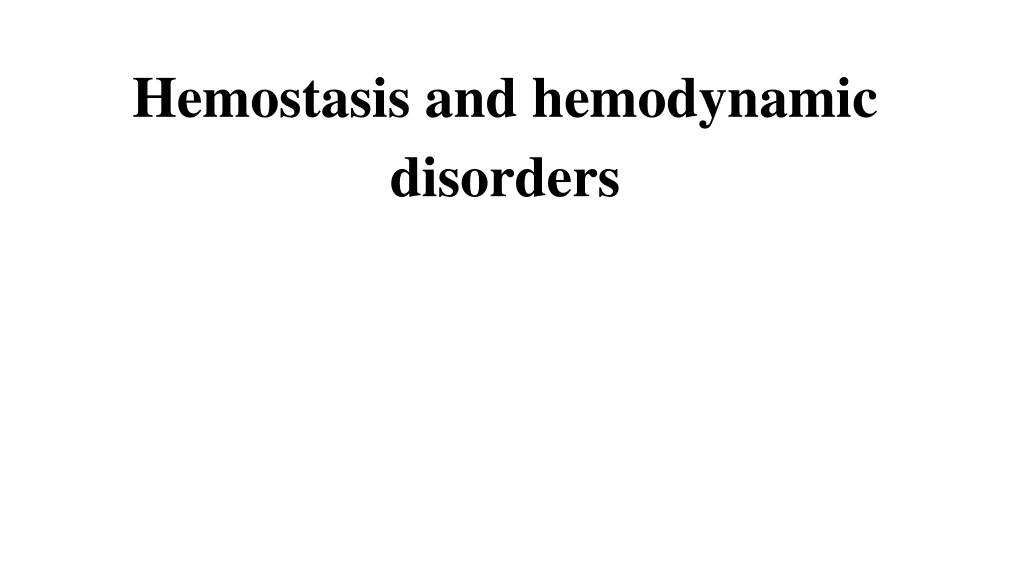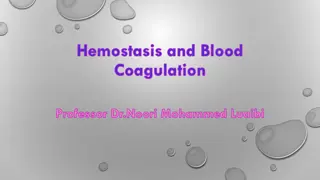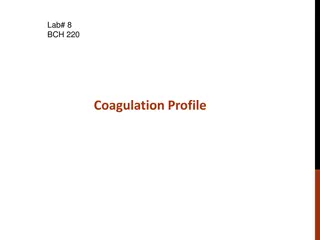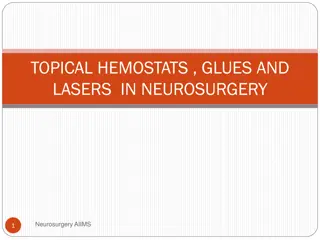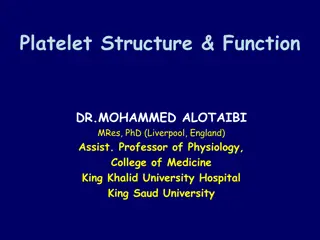Understanding Hemostasis and Hemodynamic Disorders in Health
Hemostasis is crucial for maintaining the health of cells and tissues by ensuring continuous circulation of water, oxygen, and nutrients while removing metabolic waste products. Factors controlling normal hemostasis include the integrity of blood vessel walls, blood content, platelet function, and lymphatic drainage. Disorders of hemostasis can lead to conditions such as edema, thrombosis, hemorrhage, embolism, infarction, angina, and shock. Edema, for instance, is a palpable swelling resulting from imbalances in interstitial fluid volume due to disturbances in hydrostatic and oncotic pressures.
Download Presentation

Please find below an Image/Link to download the presentation.
The content on the website is provided AS IS for your information and personal use only. It may not be sold, licensed, or shared on other websites without obtaining consent from the author. Download presentation by click this link. If you encounter any issues during the download, it is possible that the publisher has removed the file from their server.
E N D
Presentation Transcript
Hemostasis and hemodynamic disorders
Idea of hemostasis : Health of cells and organs depend on continuous circulation to deliver water, oxygen and nutrients and remove metabolic wastes products Normal Hemostasis; Definition; Continuation of blood flow to cells or tissue carrying water, oxygen and nutrients and remove tissue metabolic wastes products, maintained by integrity of blood vessel wall, lumen patency , intravascular fluid volume & pressure within certain physiologic ranges, and preserve blood in a liquid state free of clot. This is to maintain health of cells and tissue.
So The Factors control normal hemostasis : are 1) Wall of blood vessels in all its three layers (endothelial cells, subendothelial collagen and muscles). 2) Content of blood a. Vascular fluid (water) volume (hydrostatic pressure) (HP). b. Vascular plasma-albumin oncotic or osmotic pressure (OP).. c. Platelets: counts and function.. d. Coagulation factors; As substrates, enzymes, and coenzymes. e. Fibrinolytic system activity. 3. Lymphatic drainage
Diseases result from disorders of factors of normal hemostasis: 1. Edema; Excess fluid in the interstitial spaces 2. Thrombosis; blood clot obstructing lumen of blood vessels . 3. Hyperemia and congestion. 4. Hemorrhage and bleeding ; Blood loss from vascular injury . 5. Embolism: vascular obstruction by foreign body. 6. Infarction; complete obstruction of blood supply and death of tissue. 7. Angina: partial obstruction of blood supply. 8. Shock; Sever bloodloss with decrease tissue perfusion and tissue hypoxia.
What is edema? Is a palpable swelling produced by the expansion of the interstitial fluid volume , localized to (specific organ or tissue) , or generalized (in more than on organ). Body spaces and fluid are divided into: (2/3 intracellular) + (1/3extracellular) composed of interstitial and intravascular. The interstitial and intravascular exchange water and solutes in dynamic equilibrium by effect of hydrostatic and oncotic pressure (Starling forces). Pathogenesis of edema is disturbances of balance between intravascular hydrostatic pressure and oncotic (colloid osmotic) pressure or obstruction of lymphatic vessels.
Factors effecting fluid balance across capillary wall and interstitial spaces: 1. Hydrostatic pressure(HP): Pressure of plasma fluid or water, that normally about 32 mmHg at arterial side of capillary bed and 20 mmHg at venous side, Its push out flow of water into interstitial spaces carrying oxygen and nutrient for energy production to maintain health of cells, tissue and organs . 2. plasma oncotic pressure(OP), or plasma colloid pressure: pressure of plasma albumin that normally 25 mm Hg in both sides of capillary beds and it control the inflow of fluid from interstitial spaces into venous circulation carrying wastes products of energy metabolism. Oxygen+ water + nutrient = Energy production = life of cell
ShowFigure Show: Starling Factors Red arrow: Capillary hydrostatic pressure (HP) push fluid to interstitial spaces Blue arrow: Capillary osmotic pressure OP) Return fluid to veins . Net loss or gain of fluid across the capillary bed zero. The excess fluid in the interstitial spaces is drained by the lymphatic vessels, and returning to the bloodstream via the thoracic duct.
Edema refers to: Increased fluid in the interstitial tissue spaces. Mechanisms of edema: Increased capillary pressure. Diminished colloid osmotic pressure. Lymphatic obstruction. Sodium retention. Al-Madena Copy CLS 8
Causes of Starling forces disturbances A. Causes of increase (HP): Increase fluid volume: 1. Localized: Inflammation, Venous obstruction, left heart failure , Hepatic cirrhosis with obstruction of portal vein. 2. Generalized: Right side heart failure B. Causes of Decrease Oncotic pressure (OP): Decrease plasma protein (albumin), Due to: decrease intake decrease absorption decrease synthesis : liver cirrhosis Increase loss: Nephrotic syndrome , Ulcerative colitis , Burn
Classification of edema Three systems of Classification: 1. According to pathophysiological mechanism: a) Transudate: (Non-inflammatory) b) Exudate : (Inflammatory) 2) According to location (Site): a) Localized (most common inflammatory) b) Generalized or systemic 3) According to clinical finding: a) Pitting : (cardiac , renal , and liver) b) Non-pitting : (inflammatory and lymphatic).
Edema : Examples according site 1. Localized: A. Inflammatory (most common), and allergic (skin infection, insect bite, plural effusion, joint effusion, ascites of portal obstruction) B. Non-inflammatory: 1. obstruction of Venous and Lymphatic drainage 2. Pulmonary edema of left side heart failure 2. Generalized: (Cardiac , Hepatic , Renal) edema.
1. Exudative edema (inflammatory edema): Usually localized edema related to local increases in hydrostatic pressure and/or vascular permeability causing exudation of plasma albumin (protein-rich edema), inflammatory cells and excess water, with specific gravity (>1.020). 2. Transudative edema: (Non-inflammatory edema); Systemic or localized edema result from increased hydrostatic pressure or decrease plasma osmotic pressure leads to a net accumulation of extravascular fluid (edema). It is protein-poor edema with specific gravity (<1.020) and no inflammatory cells
Pathogenesis of different types of edema: Cardiac Edema A. Left side heart failure : localized pulmonary edema : Result from increase hydrostatic pressure of pulmonary vein , because blood returning to the heart through pulmonary vein is blocked. B .Right side heart failure (RHF) : Right heat failure will decrease drainage of venous blood so increase fluid volume in systemic venous circulation follow by increase hydrostatic pressure to 30 mmHg in veins side more than normal oncotic pressure (25) so the Pressure gradient will be : HP 30 OP 25= +5 on venous side cause failure of fluid retaining to veins so accumulation in interstitial spaces (edema).
Renal and Hepatic diseases edema: 1. Both cause decrease plasma albumin and decrease plasma oncotic pressure ( 15 mmHg) result in decrease fluid return to venous circulation from interstitial spaces and edema. New Starling Pressure gradient \ On arterial side will be; HP 32 OP 15= +17 cause more out flow of fluid to interstitial spaces and On venous side will be 20-15= +5 with failure return of fluid to venous circulation, so sever accumulation in interstitial spaces and sever edema 2) Liver disease (Cirrhosis) Also cause blood returning to the heart through the portal vein is blocked result increase HP and peritoneal edema (Ascites)
